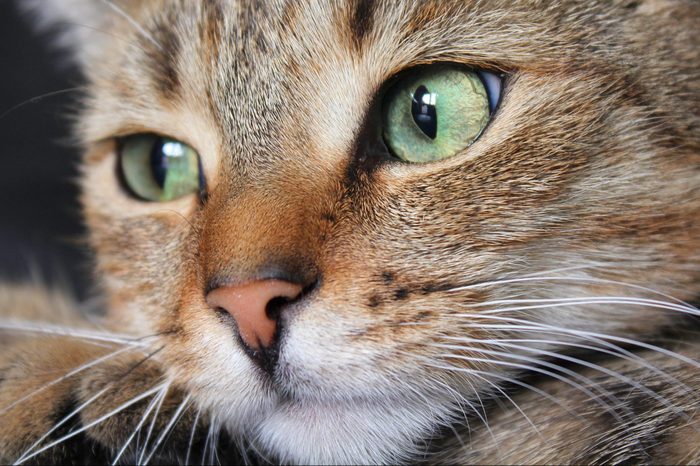Why Do Cats Have Whiskers?
Updated: Mar. 14, 2024

Yes, whiskers make your kitty even cuter. But they also serve a very important role.
As every cat owner knows, learning cat behavior is the key to understanding your particular kitty. Tuxedo, tabby, sphynx, or calico, all cats share some common traits, like claws, whiskers, and cute little toe beans. And once you know the answers to why cats knead, why cats purr, and why cats sleep so much, your own cat will be a little less of a mystery to you. But what about those funny, expressive kitty faces? Why do cats have whiskers anyway?
Why do cats have whiskers?
“The main reason that cats have whiskers is that they use them to feel and sense what is around them,” says Dr. Sara Ochoa, DVM, a small animal and exotic veterinarian, and veterinary consultant for doglab.com. “Whiskers are similar to our fingers, in that they use their whiskers to sense when something is close to them and to hunt out their prey.”
This is why cats are born with whiskers—those cute kittens are born deaf and blind, so they use their whiskers to find their way around before their other senses develop. Curious about other animals? Here’s why dogs have whiskers.
Adds Dr. Angie Krause, DVM, CVA, a holistic veterinarian and animal acupuncturist based in Boulder, Colorado: “Whiskers help cats locate themselves and other things in space.” Basically, whiskers are tuned sensory equipment to guide a cat through daily functions.
What are cat whiskers made of?
Cats’ whiskers are made out of keratin, the same thing as our hair and nails. The official name for cat whiskers is vibrissae, from the Latin term “vibrio,” which means to vibrate. In addition to whiskers on their muzzles, cats can sport whiskers above their eyebrows, coming out of their ears, and even on their forelegs. You can definitely touch a cat’s whiskers (especially when they rub their face against you), but whiskers are essential for a cat to live its best life.
How do cats use their whiskers?
Cats like small spaces, and they sometimes use their whiskers to see if they will fit into them, Dr. Ochoa says.
The tip of the whisker has a sensory organ known as a proprioceptor. Their whiskers are also sensitive enough to detect changes in the air patterns around them, which helps them steer clear of predators. Through the hair follicles, whiskers are also connected to cats’ nervous and muscular systems, making felines extremely sensitive to changes in their environment.
Although you might have wondered if cats can see in the dark, whiskers also help cats navigate their surroundings once the sun is down.
Should you trim a cat’s whiskers?
Unlike a cat’s toenails, you should never trim a cat’s whiskers. They do fall out on their own though, like eyelashes, so don’t panic if you find some around the house.
“We’re not 100 percent sure how cats experience their whiskers,” Dr. Krause says. “I don’t think they’re painful when we cut them off, but especially if your kitty can’t see or hear as well, it’s an important part of how they’re experiencing their environment.” If you’ve accidentally cut your kitty’s whiskers, don’t worry, they’ll grow back—but in the meantime, you’ll probably see some of these signs your cat is secretly mad at you.
In fact, cats’ whiskers can be so attuned to sensory stimulation that they can even affect how they eat. “We have a term called whisker fatigue,” Dr. Krause says. “Some cats are extremely sensitive about their whiskers touching the side of the bowl as they’re eating.”
Because of that, some veterinarians recommend a really wide bowl or feeding on a plate for some cats, she says. We always knew the cat would end up eating off the china! Our pets may train us well, but did you know you can train a cat?
Sources:
- Dr. Sara Ochoa, DVM, veterinarian at Whitehouse Veterinary Hospital
- Dr. Angie Krause, DVM, holistic veterinarian in Boulder, Colorado



